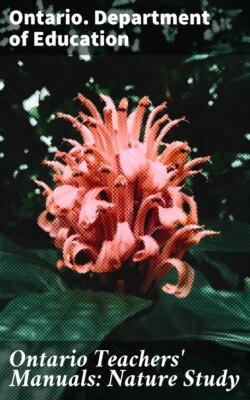Читать книгу Ontario Teachers' Manuals: Nature Study - Ontario. Department of Education - Страница 49
На сайте Литреса книга снята с продажи.
INSECTS
ОглавлениеTable of Contents
There are three classes of insects that are of immediate interest to the pupils of the Junior Grades, and the teacher who makes direct use of this natural interest has taken possession of the key to success in insect study in the primary classes.
The three classes, basing the classification upon their power to attract attention, are:
The beautiful insects, including moths, butterflies, and beetles,
The wonderful insects, including such insects as ants, ant-lions, caddice-flies, etc.,
The economic insects, including bees, silk-worms, codling-moths, etc.
Economic insects are interesting because of their relations to the occupations of the home. The successful growing of farm, orchard, and garden crops practically depends upon keeping a proper balance of insect and bird life.
The teacher who feels that his knowledge of insects is too limited to allow him to undertake the teaching of this branch of Nature Study should cast his misgivings aside; for it is not difficult for the teacher who knows nothing about insects at the outset to become acquainted with such members of the three classes named above as attract the attention of the pupils of the Nature Study classes.
The following suggestions in insect study are offered as guides to teacher or pupil:
Obtain books and pamphlets from the Department of Agriculture, Toronto, on the subject of Insect Pests on Farm Crops and Fruit Trees.
Secure a good general book on insects. Modern Nature Study, by Silcox and Stevenson, contains illustrations of several of the most common moths and butterflies, which are clear enough to make possible the identification of the forms represented. Comstock's Manual for the Study of Insects is the best general book on the subject. This, and Holland's The Moth Book and The Butterfly Book, are valuable for those who wish to follow the study of insects at any length.
Begin by studying the more conspicuous moths, butterflies, and beetles, and especially by studying the injurious forms which thrust themselves into prominence by causing destruction of grain, vegetable, or fruit crops in the locality. The utility phase of lessons on these insects will appeal to the older children and also to their parents. Moreover, these are the easiest insects to identify and upon which to obtain literature dealing with their life histories and habits.
Carefully observe the colour, size, and shape of the insect, and note the plant on which it is feeding and its manner of feeding. Consult available books on plant pests to find descriptions of the insects that feed upon this plant, and study carefully what is said about the insect observed. If this method is persistently followed, the teacher will be surprised at the rapidity with which his acquaintance with insects broadens.
Pictures of moths, butterflies, and beetles are of great assistance in the identification of these insects.
A school collection, made from the insects studied, is useful for future collection and for identification of insects. Do not allow any insect to be killed unless it is a good specimen intended to fill a place in the collection, or unless it is known to be an injurious insect. The teacher, by exercising proper control of the collecting, has an efficient means of teaching the sacredness of life. The fact should be emphasized that killing even an insect, when there is no good reason for doing so, is the act of a mean and selfish coward.
In addition to a collection of insects, including larval and pupal forms, collections of insect nests, of plant galls, of markings of engraver beetles, of burrows of tree borers, and of samples of the destructive workings of insect pests should be made.
While nothing is more beautiful than a carefully prepared collection of moths, butterflies, and beetles with their infinite variety of form and colour, nothing is more disgusting than a badly preserved collection of distorted, shrivelled, vermin-infested specimens. The teacher should avail himself of the collecting instinct which is prominent in boys of nine to fourteen years of age and of their desire to have things done well, to develop in them habits of carefulness, neatness, and thoroughness.
